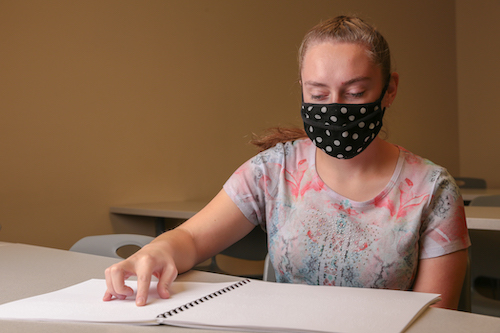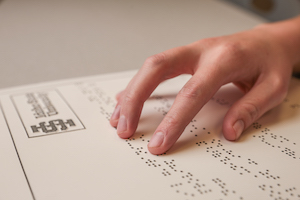Idaho State Disability Services Spotlight: Bengal Braille
November 4, 2021

Responding to the needs of some of its blind students, the Idaho State University Office of Disability Services, under the Division of Student Affairs, has embarked on an innovative pilot program to create braille reading materials in-house, saving the university hundreds of thousands of dollars and generating income, too.
Braille is a “tactile” or “by touch” writing system used by blind and visually impaired people. Generally, it is created and written on embossed paper, as ISU is producing, and braille users can also read computer screens and other electronic supports that feature braille displays.

The effort started a little more than a year ago and was inspired by the delivery of an expensive braille textbook ordered by the university that arrived so late in the semester the student couldn’t use it.
“After that, we just decided we’d try to produce some of our own braille,” said Karina Mason Rorris, Disability Services director. “When we started, we didn’t know a thing about it. We just figured it out.”
Fast-forward to now and the office has produced more than 10 braille textbooks and converts ISU class lecture notes to braille on a daily and weekly basis for students. What’s more, the Disability Services is producing braille products for Washington University in St. Louis, an effort that is bringing money into the office and the university --- a total of more than $200,000, thus far.
“I definitely appreciate the service,” said Nicole Hill, a student who is blind from Ammon, who is a sophomore in general studies. "It is really nice to have the braille. It is right there, and it is something I can access, and it makes me feel more comfortable and prepared for my classes.”
The ISU braille-producing effort was spearheaded by Rorris, Eric Hall, an administrative assistant, and Salvador Cano, a current ISU occupational therapy master’s student. They ordered the software and printers to produce braille, and then learned how to use it.
“We were so proud when we produced our first raised-dot braille document, but then we sent it to a blind student who said it was ‘gibberish,’” Hall said. “We’ve come a long way since then.”
Rorris, Hall and Cano are learning to read braille themselves, so they can better proofread and produce braille products.
“Creating culture change through advocacy, inclusion, and a solutions-focused mindset is at the core of what Karina and her team do,” said Lyn Redington, ISU vice president of Student Affairs. “They ensure Idaho State University is home for all of our Bengals.”
The Disability Services braille team has grown and either has or does include blind students who have helped proofread and consult on producing the products, Disability Services intake specialists, consultants and science specialists to interpret graphs and illustrations to be converted into braille. A variety of ISU student employees have been or are involved with the project doing everything from converting regular text into braille, to an art student who currently creates braille images for visually impaired students. Disability Services also works closely with faculty members throughout campus.
“Our ultimate goal is to eventually have an ISU Accessibility Center, where we produce braille materials and provide other accessibility services for our campus community, local community, the State of Idaho and even nationally,” Rorris said.
Creating the braille documents is a tricky, intricate, and time-consuming endeavor, which is why braille educational materials cost so much. There are numerous versions of braille used to write in many different languages. For most projects, ISU converts text using English Braille-American Edition or Unified English Braille. However, ISU will use whatever version of braille is requested by the student they are creating documents for.
STEM (science, technology, engineering and math) field documents are extremely difficult to reproduce because of the math formulas, multiple graphs and illustrations that must be converted to braille. For example, when completing a recent project, a math textbook chapter, Hall had to convert the text of the textbook using Unified English Braille, but then converted the math equations using braille Nemeth Code for science and math notation. Then he combined those alternating types into one document. Graphs and illustrations are also a challenge to recreate to ensure they are represented functionally in braille.
“For me, I am typically an auditory learner, but for classes like chemistry or anatomy, things with a lot of visuals in them, I find braille useful, and without braille I don’t think I could have gotten the grades that have,” said Quincie Mattick, a student who is blind from Colorado Springs, Colorado, who is pursuing a bachelor’s degree in health science. “I have all my exams in braille, especially for those classes, and honestly, if I didn’t have them in Braille, I probably would have had worse grades.”
It isn’t just textbooks Disability Services is creating using braille. Note-takers from Disability Services will take notes from a class and those notes are converted into braille for some students—a fast-paced process with a quick turnaround time.
The ISU Disability Services pilot braille program still cannot meet all of Idaho State’s braille needs in each semester. The office still contracts with vendors for some materials or for help in producing other materials. However, the program is growing and producing more materials for ISU’s visually impaired students and has great potential for the future.
“We are committed to creating equal access and opportunities for those we serve! Our students are amazing and are very important to us,” Rorris said. “I would also like to add that our endeavors are not possible without the support of our amazing faculty whom we rely on to get us the materials we need in a timely manner.”
Categories:
